Intel Core i7 3960X (Sandy Bridge E) Review: Keeping the High End Alive
by Anand Lal Shimpi on November 14, 2011 3:01 AM EST- Posted in
- CPUs
- Intel
- Core i7
- Sandy Bridge
- Sandy Bridge E
Gaming Performance
Most games have a tough enough time stressing more than four cores, so the move to the 3960X won't do much for gaming in most cases (particularly when GPU bound). That being said, the added cache may help give SNB-E a slight bump over its quad-core brethren.
Civilization V
Civ V's lateGameView benchmark presents us with two separate scores: average frame rate for the entire test as well as a no-render score that only looks at CPU performance.

In GPU bound scenarios the 3960X is no different than the 2600K. Civ V is a unique game in that its CPU workload does scale reasonable well across multiple cores:
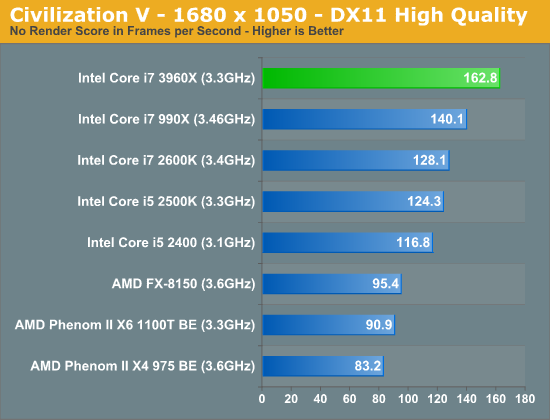
Here the 3960X is nearly 30% faster than the 2600K.
Crysis: Warhead
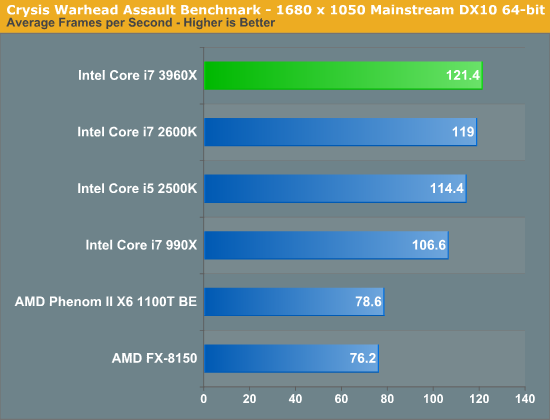
Dawn of War II
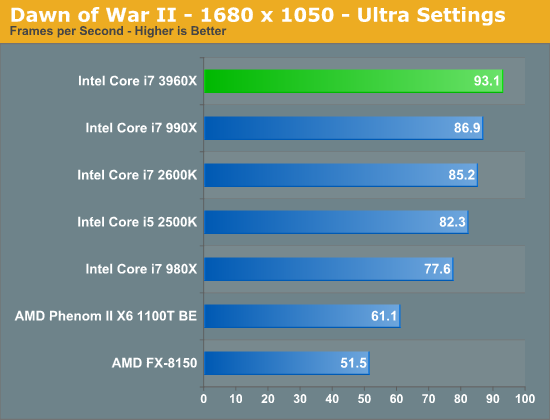
The larger cache helps give the 3960X a 9% advantage over the 2600K in Dawn of War II. At 1680 x 1050 the game isn't entirely GPU bound on our 5870.
DiRT 3
We ran two DiRT 3 benchmarks to get an idea for CPU bound and GPU bound performance. First the CPU bound settings:

DiRT 3 is an example of a CPU bound title (at lower resolutions) that doesn't scale well with core count or cache size. The 3960X is barely 2% faster than the 2600K.
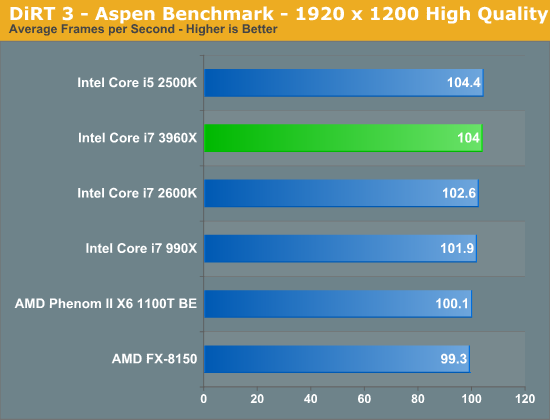
Metro 2033
It is interesting to note that while SNB-E and SNB perform similarly here, both parts do offer a performance improvement over the Gulftown based 990X.
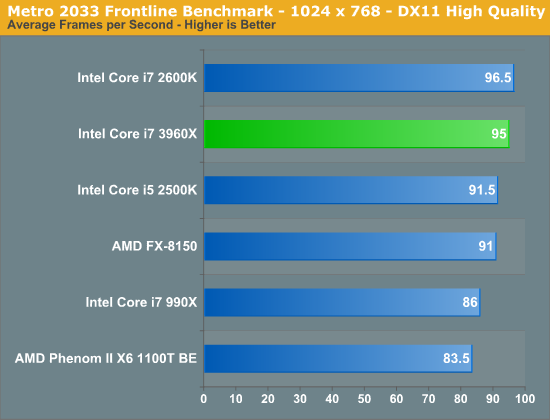
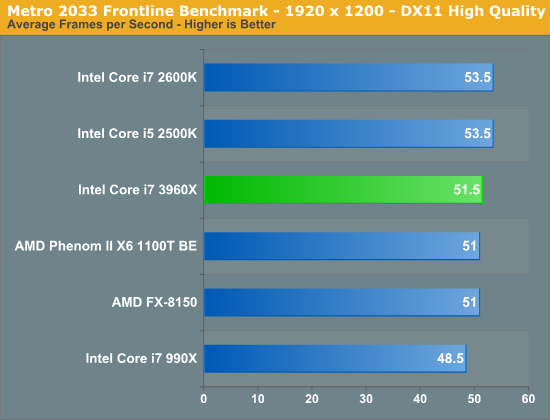
Rage vt_benchmark
While id's long awaited Rage title doesn't exactly have the best benchmarking abilities, there is one unique aspect of the game that we can test: Megatexture. Megatexture works by dynamically taking texture data from disk and constructing texture tiles for the engine to use (note that Rage doesn't store textures in a GPU-usable format). As a result whenever you load a texture, Rage is transcoding the texture on the fly. This is normally done by the CPU.
The Benchmark: vt_ are all the virtual texture commands. Vt_benchmark flushes the texture cache and then times how long it takes to transcode all the textures needed for the current scene, from 1 thread to X threads. Thus when you run vt_benchmark 8, for example, it will benchmark from 1 to 8 threads (the default appears to depend on the CPU you have). Since transcoding is done by the CPU this is a pure CPU benchmark. I present the best case transcode time at the maximum number of concurrent threads each CPU can handle:
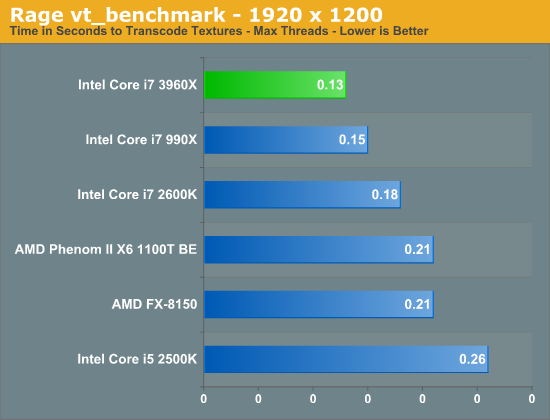
Starcraft 2
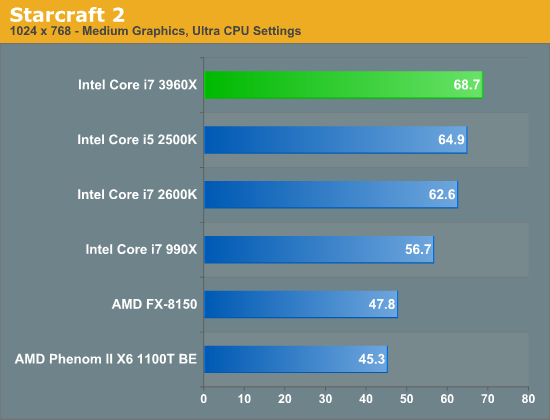
World of Warcraft
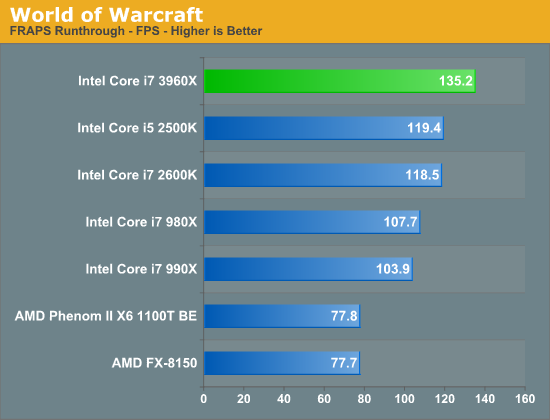
WoW does enjoy the 3960X's larger cache, here we see a 13% increase in performance compared to the regular Sandy Bridge parts.










163 Comments
View All Comments
ggathagan - Monday, November 14, 2011 - link
You assume correctly.As stated in the article, the 3820 is due out early next year and expected to run at about $300.
If you look at the 1st page of the article, you'll note that the 3820 is a little faster than the 2700K, with the same max in turbo mode and a larger L3 cache.
DanNeely - Monday, November 14, 2011 - link
Except that the 2700k is unlocked and the 3820 has a severe overclocking limit.theangryintern - Monday, November 14, 2011 - link
Thanks for the great review, Anand. I had been waiting for SNB-E to do an upgrade from my X58 Core i7, but now I'm thinking of saving some money and going with a regular Sandy Bridge, the gaming gains just aren't enough to justify the added expense.Makaveli - Monday, November 14, 2011 - link
That makes no sense there are no gaming games going from X58 to SB!You will still be GPU bottlenecked on most games!
And a whole new build will be an added expense for no gain in Games!
Beenthere - Monday, November 14, 2011 - link
Not much to see here except over-priced CPUs and mobos. Nice to see Intel fans smartening up and passing on these cash cows.Lazlo Panaflex - Monday, November 14, 2011 - link
Hi Anand, thanks for the review :)Apologize in advance if this was asked earlier, but what specifically is your criteria for determining a stable overclock? For example, do you run Prime95, large FFT's for a predetermined period of time, or perhaps IBT (Intel Burn Test) for a certain amount of runs? Or do you utilize some other tool? Just curious, since this question often pops up in the CPU forums, and everyone has their own opinion of what constitutes a stable overclock.
Regards,
LP
yankeeDDL - Monday, November 14, 2011 - link
LOL. Supply and the mand is the cause. Jacking up the price is the effect. You are a bit mixed up it seems.Also, in the consumer market having the fastest CPU (or GPU) that you sell for a ridiculous price doesn't mean that someone buys it.
How many people buy a HD6990? Few, and that's why supplies are so scarce.
The 3960X is a "show off" chip that claims performance crown. Anyone in the right state of mind will not buy it: it is just not worth the money it costs, unless you're in absolute need of few extra % of performance.
JlHADJOE - Tuesday, November 15, 2011 - link
We have chips priced at $1000 because the market has shown that it is willing to pay that amount to get the top-performing chip. It doesn't matter that AMD doesn't have an entry in that segment, because if it did, then we'd probably have AMD's FX-9300 or something priced at $900, while Intel sells their 3960X at $1100.This was the exact case when AMD was competitive, and their FX-57 was sold at $1100, vs Intel's Pentium EE which was going for $999. Was there a competitive AMD at the time? Yes. They were even in the lead. Were prices still jacked up? Yes.
The $1000 CPU will only go away if we, as consumers wise up and say we are not willing to pay that much money for a chip.
karkas - Monday, November 14, 2011 - link
Rapid STORY Technology?GTVic - Monday, November 14, 2011 - link
Lack of Quick Sync is not nearly the negative that the reviewer seems to think it is. It is not a well supported technology and not many people would use it on a day to day basis. This shouldn't even be mentioned in the article unless you also want to bring up support for Intel Viiv http://en.wikipedia.org/wiki/Intel_Viiv.